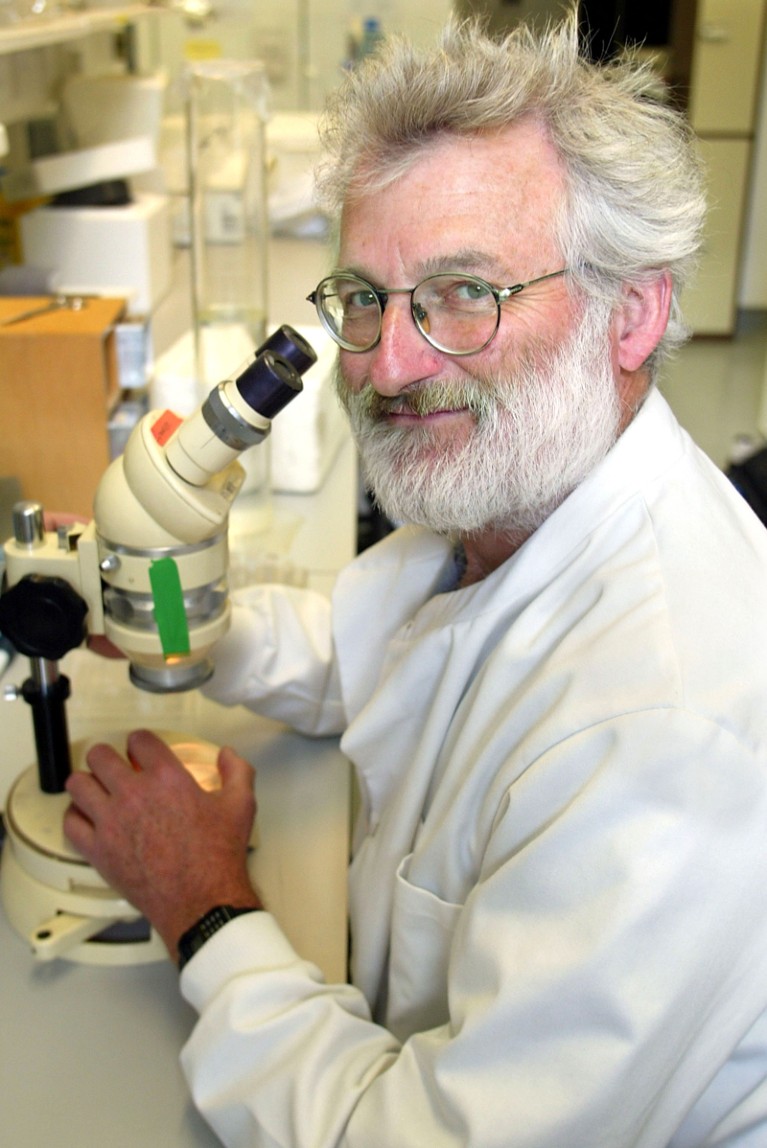
John Sulston.Credit: Scott Barbour/Getty
The principle that genomic data should be universally shared without commercial involvement owes its widespread acceptance largely to John Sulston. As leader of the British contribution to the international Human Genome Project, Sulston persuaded funders and colleagues of the crucial importance of making a complete, high-quality sequence freely available to the global scientific community. His commitment stemmed from a moral certainty that profit as a motive had no place in science.
In 2002, he shared the Nobel Prize in Physiology or Medicine for his contribution to understanding how genes control the fate of cells in the developing roundworm Caenorhabditis elegans. In his work on the worm cell lineage and, later, genome sequencing, Sulston promoted the idea that investing in large-scale data collection without a specific hypothesis has long-term benefits.
Sulston, who died on 6 March, was the son of an English clergyman and a teacher. He took to heart his parents’ indifference to material wealth and their desire to work for the common good. Mechanics fascinated him from an early age and, by dissecting dead animals, he began to see living things, too, as machines. He won a scholarship to study natural sciences at the University of Cambridge, UK.
His PhD, also at Cambridge, was on the synthesis of oligonucleotides — the building blocks of nucleic acids such as DNA and RNA. His flair as an experimentalist secured him a position as a postdoc with organic chemist Leslie Orgel at the Salk Institute for Biological Studies in La Jolla, California, investigating the origins of life. Sulston arrived in 1966 to study the replication of nucleic acids, and, for the first time he understood the evolutionary context of his work in chemistry.
There, too, Sulston met Francis Crick, co-discover of the DNA’s double helix; Crick recommended him for a post at the Medical Research Council’s Laboratory of Molecular Biology back in Cambridge. In 1969, Sulston joined a small group headed by geneticist Sydney Brenner. Looking for a model organism in which to explore the interactions of genes, development and behaviour, Brenner chose C. elegans. The tiny worm has only 959 cells as an adult, yet it has a gut, a nervous system, gonads and a repertoire of behaviours to move, feed and reproduce.
It is also transparent. Sulston used what became his favourite tool, the Nomarski differential-interference contrast microscope, to visualize cell nuclei in living worm larvae and, later, in the more challenging embryos. He observed and recorded the invariant sequence of cell divisions that build an adult worm. His work provided a foundation for future worm biologists to answer questions about development that have implications for other species, including our own.
Sulston spotted that certain cells are eliminated during development. He began to explore the genetics of this process with US postdoc Robert Horvitz. On his return home to the Massachusetts Institute of Technology in Cambridge, Horvitz discovered genes that regulate programmed cell death. Later, mutations in these genes proved instrumental to understanding the uncontrolled multiplication of cancer cells. Sulston, Horvitz and Brenner shared the 2002 Nobel prize “for their discoveries concerning genetic regulation of organ development and programmed cell death”.
From 1983, Sulston set out to map and sequence the 100-million-base-pair genome of the worm. His lab worked in partnership and friendly competition with that of Robert Waterston, then at the University of Washington in St. Louis. In 1989, their collective drive motivated Jim Watson, then head of the Human Genome Project, to fund their pilot sequencing initiative. The worm project demonstrated that automated, high-throughput sequencing of the human genome was not impossible. In 1992, the UK Wellcome Trust invited Sulston to head its new sequencing facility, the Sanger Centre (now the Sanger Institute), in Hinxton.
Leading the Sanger as part of an international consortium, Sulston had a key role in establishing the principles of data release and open access. When, in 1998, a private initiative led by Craig Venter of Celera Genomics announced its intent to sequence the human genome first, and for commercial profit, Sulston defended the principle of open data. He became, with Francis Collins — then head of the US National Human Genome Research Institute — a leading voice in persuading both the US National Institutes of Health and the Wellcome Trust to commit to the project’s completion. The human genome sequence, finished to a standard of 99.99% accuracy, was published in Nature on 21 October 2004 (International Human Genome Sequencing Consortium Nature 431, 931–945; 2004).
As Sulston predicted, the availability of the complete human genome drove research, both academic and commercial, worldwide. The work is slowly delivering clinical applications, especially in areas such as cancer, where genetic mutations determine whether a tumour will be sensitive to a therapy. Meanwhile, technology has advanced and costs have dropped such that whole-genome sequencing of individuals might soon be routine.
Sulston was hands-on in the lab, personally preparing the worm-clone library for the mapping project, and decrypting the early sequencing machines so that the electronic data could be analysed directly. But he always valued collaborators with skills different from his own, and co-managed the Sanger on a board of seven people. When he asked me to co-author a book on the battle for the human genome, The Common Thread, he insisted that we work as equal partners.
After the human sequence was published, Sulston devoted himself to writing and speaking in support of open access and, more broadly, on the relationship between science and society. Warm and articulate, he won over audiences with his humility and passion.




